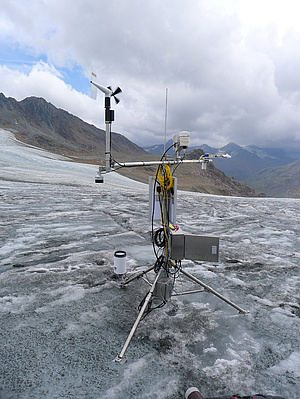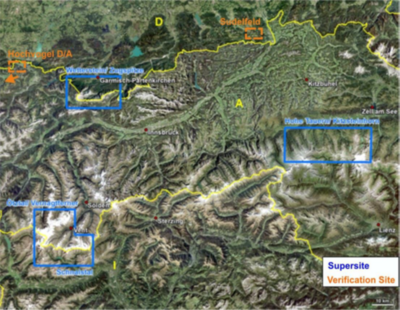Bavarian glaciers
The geodetic observation of the Bavarian glaciers dates back to the late 19th century. Due to this long observation period, the small Bavarian glaciers, which still exist today at the Zugspitze (Höllentalferner, Northern Schneeferner) and in the Berchtesgaden Alps (Watzmanngletscher, Blaueis), are very valuable “climate witnesses”. The first accurate map was created by Sebastian Finsterwalder, who mapped the Zugspitzplatt in 1892 using terrestrial photogrammetry. His son and co-founder of the Commission for Glaciology, Richard Finsterwalder, carried out measurements of all Bavarian glaciers during the mid-20th century, and from the 1960s onwards, the Commission for Glaciology established regular photogrammetric monitoring procedures at intervals of about 10 years. The transition to the digital age took place between 2005 and 2007 as part of a German Research Foundation project (Deutsche Forschungsgemeinschaft, DFG). Since then, the five glaciers (status 2014) have been monitored with laser scanning and real-time kinematics at shorter observation intervals of approximately 5 years. These continuous observations were summarised for the general public in the Bavarian Glacier Reports (1st edition: 2014, 2nd edition: 2021) published by the Bavarian State Ministry of the Environment and Consumer Protection. After the extreme melt in summer 2022 measurements of the Southern Schneefernerat the Zugspitze revealed that area as well as ice thickness had decreased to such extent that the remains can no longer be regarded as a glacier. This reduces the number of glaciers in Germany to four.
Mass balance of East Alpine glaciers
In addition to the intensive observation of the Vernagtferner in the Ötztal valley, where the Academy maintains a research laboratory, other glaciers in the Eastern Alps are examined at regular intervals. This allows for more detailed observations at the Vernagtferner to be regionalised and the development of the glaciers in the Eastern Alps to be investigated more generally. To this end, the glaciers in Bavaria and a selection of glaciers in the Zillertal and Stubai Alps have been observed for more than forty years.
AlpSenseRely

Alpine remote sensing of climate-induced natural hazards: Reliability of multi-method hazard prediction in a changing climate
AlpSenseRely ist eine dreijährige Zuverlässigkeits- und Potentialstudie in 4 alpinen Regionen (Bayern, Tirol, Land Salzburg und Südtirol) zu hochverfügbaren Remote Sensing gestützten Frühwarnsystemen für Naturgefahren in besonders Klimawandel-sensiblen alpinen Räumen. AlpSense bearbeitet drei Problemfelder: (1) Pro- und periglaziale Dynamik und Hangbewegungen, (2) Gletscherentwicklung und Gletscherdynamik und (3) Multiskalige Fernerkundung und 3D-Visualisierung. Dabei werden eine innovative Kombination von optischen, Radar- und Infrarotsensortechnologien (satellitengestützt, luftgestützt und terrestrisch) als auch neuartige geophysikalische (elektrische & seismische), geochemische (Eisisotopensignale), glaziologische (3D-Ablation, Radartechnologie) und geodätische Methoden (Infrarot-Koregistrierung) verwendet. AlpSense flankiert die EUSALP-Strategie für die Entwicklung des alpinen Raums und arbeitet mit wichtigen Infrastrukturanbietern, Regierungsbehörden, Berg- und Rettungsvereinen zusammen
Die KEG trägt insbesondere mit der Modellierung der Variabilität der Schneedecke und der damit verbundenen Dynamik des Schmelzwasserabflusses zum diesem Projekt bei. Auf Basis der meteorologischen Beobachtungen und der Eigenschaften der Schneedecke in Kombination mit den Abflussmessungen an der Pegelstation Vernagtbach können entscheidende Kontrollparameter zur Abschätzung von Risikosituationen aus dem glazialen Umfeld identifiziert werden. Dazu werden speziell Hochwassersituationen an der Pegelstation genutzt um kritische Anomalien in den Daten zu Schneedeckenfeuchte, Wasserperkolation und Meteorologie zu identifizieren. Aus dieser Analyse können dann signifikante Parameter ausgewählt und Kriterien zur Definition von Gefährdungsniveaus abgeleitet werden. Aufgrund der flächenhaften Beschreibung des Schneedeckenzustands ist es möglich potentielle langfristige Änderungen zu modellieren. Damit soll die Bandbreite der Reaktion der Schneedecke und des Gletscherabflusses auf unterschiedliche klimatische Bedingungen und unterschiedliche Gletschergeometrien bestimmt und die Konsequenzen im Hinblick auf Gefährdungspotentiale zu quantifiziert werden.
Kooperationspartner:
- Technische Universität München (Projektleitung)
- Ludwig-Maximilians-Universität München
- FAU Erlangen-Nürnberg
- Universität Wien
- Forschungsgesellschaft Georesearch mbH Salzburg
Finanziert vom Bayerischen Staatsministerium für Umwelt und Verbraucherschutz
Alpine glaciers as climate indicators

Alpine glaciers are considered icons of climate change. Their almost continuous melting since the middle of the 19th century impressively illustrates the changing alpine climate during this period. This has far-reaching consequences for the environment in the Alpine region. Despite this apparent causality, there are still some questions about the unambiguous relationship between climate change and glacier behaviour on a regional scale:
Is the melting of a glacier a direct consequence of a particular change in climate? Is the relationship between climate and glacier reaction constant over time? Can glaciers from different regions of the Alps be directly compared in their response to climatic changes? What conditions triggered glacier growth? Based on long-term observations of Alpine glacier mass changes and parallel climate records, these data can be analysed for trends and correlations that indicate both a critical turning point around 1980 and a remarkable acceleration of climate change in the period that followed.
Such process-oriented and bidirectional interpretations require considerably more differentiated knowledge of the relationship between local climate and glacier behaviour than has been developed in previous studies. The very extensive and heterogeneous range of observational data available today on glaciers and climate in all Alpine countries forms the ideal basis for investigating the spatial differentiation of climate change in the Alpine region. For this purpose, a uniform database that is comparable throughout the Alps needs to be created first. The results expected from the project will provide a better understanding of the regional impacts of climate change and thus make an important contribution towards interpreting research that has been carried out internationally and nationally, for example by the Virtual Alpine Observatory (Virtuelles Alpenobservatorium, VAO). An intensive exchange of data and knowledge in the VAO network is essential for this project because, firstly, a common database is a prerequisite for improved analyses and forecasts, and secondly, interpreting the climate sensitivity of high alpine systems can be improved on the basis of the expected results.
For the first time, the project initiates an alpine-wide collection, archiving and homogenisation of the available geodetic and glaciological data and instrumental climate observations, which are made available within the VAO for further investigation. In a second step, the relevant glaciological and meteorological parameters are extracted from this data, which serve as input variables for local and regional model analyses of the relationship between glacier and climate. Targeted geodetic and meteorological field measurements in cooperation with the VAO observatories are carried out to update and evaluate these parameters and specific processes. On this basis, the principal questions, in particular the causal relationship between topography, ice dynamics and anomalies of regional glacier balances as a function of climate series, are investigated. These findings are an important contribution to the assessment of climate-induced environmental changes and the resulting strategic planning. The results and homogenised data sets will be made available for further research.
Project of the Bavarian State Ministry of the Environment and Consumer Protection
Project title: Alpine glaciers as climate indicators - Spatial differentiation of climate change from the analysis of homogenised heterogeneous data sets of glacier inventories and climate parameters
Project manager: Christoph Mayer
Project number: TKP01KPB-7075
AlpSenseBench

The one-year project AlpSenseBench is a benchmark project set up to develop early warning systems for natural hazards in alpine areas that are under particular pressure due to their high sensitivity to climate change. Hereby, the infrastructure of these alpine spaces is subjected to high risks, paired with significant financial impact. AlpSenseBench aims to reduce these risks through their measurement-based anticipation and real-time warning. The project's four specific research areas are located in Bavaria, Tyrol, the State of Salzburg and South Tyrol.
In AlpSenseBench, the Geodesy and Glaciology group of the Academy focuses on analyzing the contribution of snow melt to runoff on the Vernagtferner, a glacier in the Ötztal Alps. In order to research this, a measuring station including radar was placed on the Hochvernagtplateau (3500 m.) in April 2018. These measurements will contribute to detailed observations of the glacier's snowpack and will be complemented by data from weather stations in the immediate research area. In combination with numerical modelling of snowpack- and glacier changes, this adds to a comprehensive understanding of melt and runoff processes, which will present a useful contribution to effective water management in the region.
Partners:
- Technical University of Munich
- Ludwig-Maximilians-University Munich
- University of Viena
- research corporation Georesearch mbH
Project funded by the Bavarian Ministry of Economic Affairs, Energy and Technology

